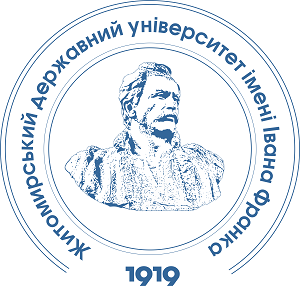CHEMICAL AND MICROBIOLOGICAL ANALYSIS OF WATER FROM THE MALA PUTYATYNKA RIVER: ASSESSMENT OF ECOLOGICAL SAFETY
DOI:
https://doi.org/10.32782/naturaljournal.13.2025.34Keywords:
environmental safety, microbiological pollution, chemical analysis of water, heavy metals, water quality monitoring, urbanized water bodiesAbstract
Research on the water quality of small rivers is an important aspect of assessing the ecological state of water resources, as they play a significant role in maintaining the natural balance. The growth of urbanization, industrialization and increased agricultural production cause significant anthropogenic load on water bodies, which leads to changes in the chemical composition of water and aggravation of the pollution problem. The Malaya Putyatynka River, which is a left tributary of the Teteriv River,is significantly affected by economic activity, which is accompanied by changes in its hydrochemical composition, accumulation of pollutants and a decrease in its ability to natural self-purification.A significant part of the river bed has been transformed, which limits natural self-purification processes, and the ingress of domestic and industrial wastewater creates potential environmental risks for the region.The assessment of the ecological state of the river was carried out on the basis of physicochemical and microbiological analysis of water samples that were taken in accordance with methodological requirements. The research methodology was based on determining key hydrochemical indicators, such as pH, turbidity, alkalinity, total hardness, concentration of biogenic compounds, content of heavy metals, as well as the level of permanganate oxidation. The analysis showed significant deviations in water quality indicators, which indicates a strong anthropogenic impact. It was found that the ammonium concentration was 5.72 mg/dm³, which significantly exceeds the regulatory values, which may be a consequence of household or industrial wastewater entering the water body. Permanganate oxidation reached 8.08 mgO₂/dm³, which indicates a high level of organic pollution. The concentrations of chlorides and sulfates were 115 mg/dm³ and 88 mg/dm³, respectively, which also exceeds the regulatory values and indicates a significant chemical load.Microbiological analysis showed significant bacterial contamination, in particular, the total number of coliform bacteria in the studied samples was 3×10³ CFU/100 ml, which significantly exceeds the standards established for recreational and domestic drinking water bodies. The results obtained indicate a high level of organic and bacterial contamination, which creates risks for the biological diversity of the aquatic ecosystem, and may also pose a threat to public health. The analysis of the dynamics of pollution after recording the discharge of pollutants showed that a week after its cessation, a partial improvement in water quality was observed, in particular a decrease in the concentrations of biogenic elements. This indicates the presence of self-purification mechanisms of the river, but their effectiveness is significantly limited due to the high load of pollutants. The results obtained confirm the significant impact of pollution on the river and emphasize the need to improve the environmental monitoring system and implement environmental protection measures to minimize the negative impact on the ecosystem. It was found that the natural potential of the river for self-purification is limited, which may lead to long-term degradation of the ecosystem if current pollution trends persist. The data obtained are of practical importance for the development of effective environmental protection measures aimed at improving the condition of small rivers within urbanized areas. The introduction of modern methods of wastewater treatment, increased control over economic activities and improvement of the monitoring system will reduce the level of anthropogenic load and contribute to the restoration of the river's ecosystem balance.
References
Алпатов О.С., Циганенко-Дзюбенко І.Ю., Луньова О.В. Особливості моніторингу малих річок в умовах Полісся. Всеукраїнська науково-практична конференція здобувачів вищої освіти і молодих учених «Сталий розвиток країни в рамках Європейської інтеграції», 30 листопада 2022 року. Житомир : Житомирська політехніка, 2022. С. 65–66. [Електронний ресурс] URL: https://conf.ztu.edu.ua/wp-content/uploads/2023/01/65.pdf (дата звернення: 10.03.2025).
Главацька Н. Гідроекологічний стан річок в межах міста Житомира. Міськість: наука, культура, мистецтво. 2015. № 5 (2). С. 86–91. [Електронний ресурс] URL: http://eprints.library.odeku.edu.ua/id/eprint/1540/1/Glavatska_Gidroek_stan_M_2015.pdf (дата звернення: 12.03.2025).
Державна екологічна інспекція у Житомирській області. Річка Путятинка навесні очима небайдужих. 2023. [Електронний ресурс] URL: https://dei.zt.ua/novyny/451-richka-putiatynka-navesni-ochyma-nebaiduzhykh (дата звернення: 12.03.2025).
Державні санітарні норми та правила «Гігієнічні вимоги до води питної, призначеної для споживання людиною» (ДСанПіН 2.2.4-171-10) : затв. наказом МОЗ України від 12.05.2010 р. № 400, зареєстр. в Мін’юсті України 01.07.2010 р. за № 452/17747. [Електронний ресурс] URL: https://zakon.rada.gov.ua/laws/show/z0452-10 (дата звернення: 10.03.2025).
Мислива Т.М., Кот І.С. Важкі метали у водах малих річок і боліт Житомирського Полісся. Вісник Житомирського національного агроекологічного університету. 2011. № 2. Т. 1. С. 58–68. [Електронний ресурс] URL: http://lib.znau.edu.ua/jspui/handle/123456789/1234 (дата звернення: 10.03.2025).
Павельчук Є.М., Сніжко С.І. Гідролого-гідрохімічні характеристики річок Житомирського Полісся в умовах глобального потепління. Житомир : Волинь, 2017. 244 с.
Слободенюк М.О., Підліснюк В.В. Вплив антропогенних факторів на екологічний стан річки Тетерів. Наук. вісник Нац. аграрного ун-ту. 2006. № 95 (2). С. 166–171.
Слободенюк М.О. Підліснюк В.В. Екологічна оцінка якості води в р. Тетерів за інтегральними показниками. Наук. вісник Нац. аграрного ун-ту. 2007. № 107 (1). С. 161–167.
Шелюк Ю.С. Особливості міграції хімічних елементів у водосховищах річки Тетерів. Гідробіологічний журнал. 2016. Т. 52. № 5. С. 93–107. https://doi.org/10.1615/HydrobJ.v52.i5.90.
Tsyhanenko-Dziubenko I., Kireitseva H., Demchuk L., Vovk V. Hydrochemical determination of the Teteriv River and the Kamianka River eutrophication potential. 17th International Conference Monitoring of Geological Processes and Ecological Condition of the Environment. Nov 2023; Vol. 2023, p. 1–4. https://doi.org/10.3997/2214-4609.2023520089.







